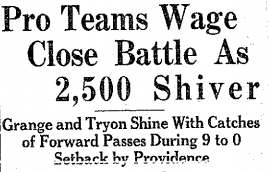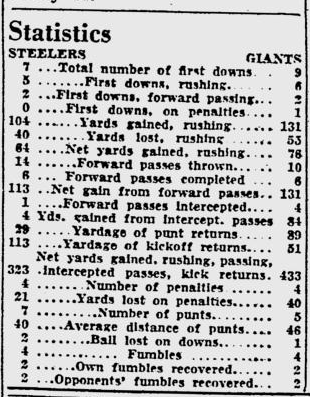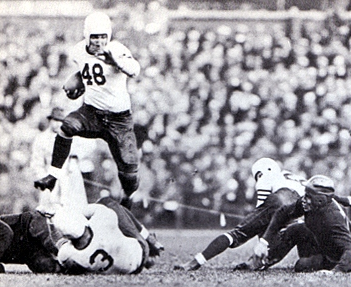Pro football has always been a bit behind in the Numbers Racket. No joke: Recordkeeping was so slipshod in the late ’30s that the NFL didn’t even know who its all-time leading rusher was. (It just thought it did.)
But that’s a story for another day. Instead, let’s talk about a couple of early attempts to swim against the tide, to look at statistics — and the game — in a different light. The first is from the Dec. 4, 1927, Syracuse Herald. The day after a neutral-site battle between Red Grange’s New York Yankees (the “home” team) and the Providence Steam Roller, the newspaper ran this graphic:

 How cool is that? It’s 1927 — 1927! — and you’ve got a paper keeping track of the distance passes traveled in the air and how far receivers ran after the catch. Yards After Catch didn’t really enter the football lexicon until the 2000s, but here’s the Herald charting it in the Red Grange era. It’s a shame we don’t know who dreamed up the idea. The guy was way ahead of his time.
How cool is that? It’s 1927 — 1927! — and you’ve got a paper keeping track of the distance passes traveled in the air and how far receivers ran after the catch. Yards After Catch didn’t really enter the football lexicon until the 2000s, but here’s the Herald charting it in the Red Grange era. It’s a shame we don’t know who dreamed up the idea. The guy was way ahead of his time.
(This, by the way, was the year before the Steam Roller won the NFL title. “Conzelman” is Hall of Famer Jimmy Conzelman, their player-coach, who later coached the Chicago Cardinals to the 1947 championship.)
We move ahead to 1941 — and a box score that appeared in the Pittsburgh Press after the Giants whacked the Steelers, 37-10. Many papers back then just ran basic information (who started, who substituted, who scored, who officiated, etc.). But the Press went above and beyond. Take a look, and then we’ll discuss it.
A couple of things jump out — the “Ball lost on downs” category, for instance. Even today’s box scores don’t include that. So it’s interesting that, in a period when stats were hard to come by, it was part of the Press’ package. But, hey, why shouldn’t it be, then or now? Fourth-down stops can be some of the biggest plays in a game.
Even more intriguing, though, is “Net yards gained, rushing, passing, intercepted passes, kick returns.” Can’t say I’ve seen that anywhere else. What it looks at, essentially, is how far a team advanced the ball — by any and all means (except fumbles, for whatever reason).
As you can see, the Giants came out ahead here, too — 433-323. But it’s debatable how useful or revealing a statistic it is. After all, a club that’s getting smoked can rack up a lot of yards returning kickoffs.
Still, you can appreciate the Press’ willingness to depart from the norm and give readers a little extra. Especially when the esteemed New York Times was casually reporting (in 1936): “[Tuffy] Leemans gained 117 in 20 tries to bring his yardage for the season to 502. At the rate he is going he bids to surpass Beattie Feathers’ league record of slightly more than 1,000.”
Slightly more than 1,000. That’s where the NFL was in those days — and change was slow in coming. But some folks, at least, were trying.

